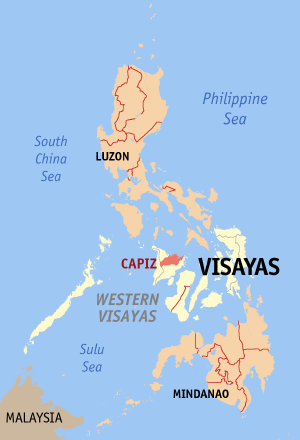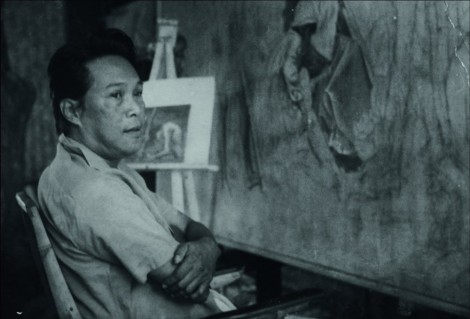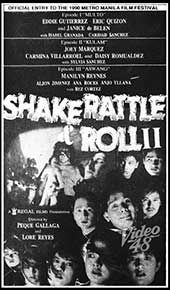
Introduction: A Piece of Painting
When I visited Fukuoka several years ago, I wandered off to the Fukuoka Asian Art Museum, which I had been interested in for some time. Among their rich collection of paintings and art works from different Asian countries, I was transfixed by a painting titled “Progress through Education” by a Filipino painter Carlos V. Francisco. While depicting an enlightening image of education and development, there was a monstrous figure, with its internal organs dangling from its severed waist, looming over like noise in the upper part of the canvas; that was, unmistakably, an Aswang. The image of “superstition” that should have faded away through education and development converged there. Little did I expect that I would come across Aswang again in such place. It seems that my journey in search of Aswang is not over yet.
Aswang, its Past and Present
Aswang is a supernatural being, and frequently appears in the folk beliefs and folklores of the Philippines, especially in those of Christian communities in lowland areas. People speak of Aswang in diverse forms, however, it is said that they can roughly be classified into 5 different categories: (a) Vampire, (b) Entrails-Sucker, (c) Therianthrope, (d) Ogre, (e) Sorcerer (Ramos 1990). The one I saw in Carlos V. Francisco’s work was an Aswang floating about in the form of “Entrails-Sucker.” Furthermore, in recent years, forms of Aswang seem to be diversifying in the media as well in the urban legends.
My first encounter with Aswang took place when I was living abroad in Manila as a student at a local university. Each room of the men’s dormitory was shared by four students. Filipino students from all over the country who came to study in Manila never forgot enjoying conversations with each other or playing together in their spare time, though they were busy studying. Our lively days continued in that way. It was one of my pleasures in those days, to listen to the ghost stories my roommates told in hushed voices, before we fell asleep in beds at midnight. Then, it was such trivial tales of ghosts in which Aswang was a popular topic. Yet with regional varieties, the stories of Aswang seemed to have a certain level of decided formats. Roommates from different regions appeared to have shared the fun and thrill of these tales. Little by little, I developed my curiosity to know more about Aswang, while I was drawn into the charm of dual other worlds: ghost stories in the Philippines.
As I researched, Aswang can be traced back to the 15th to the 16th centuries, when it had already appeared on historical documents recorded by the Spaniards, the colonists. In these papers, Aswang was depicted as “a native superstition” from the view point of Spanish missionaries, trying to propagate their Catholic beliefs, or as “a demon” standing against their God (Plasencia 1903-09; Ortiz 1903-09). Having observed the periods, dominated by the Spanish, the Americans, as well as by the Japanese militarists at the time of World War II, it was after the independence, amid the movement of nationalism, under the dictatorship of Ferdinand E. Marcos, when Aswang came to establish its status in the nation’s folk beliefs and folklores. Particularly, research conducted by Ramos mentioned above, extensively collected and recorded the folklores of Aswang from almost all over the nation, revealing the circulation, commonality and diversity of the belief and the folklores at a national level, while covering farms, fishing villages and urban areas. In that way, Aswang, established as a “national monster,” goes further on to expand the context of its stories.
Aswang in the Media
The “national monster,” Aswang doesn’t only hide in farms, fishing villages, or deep in the mountains in the countryside, but as an image it is also mentioned in urban legends. It is described, at times, as an old woman, running like wind on a highway in Manila, or as a motherly figure, who has been affected by the power of evil, while working abroad and as a result, slaughters and eats her own children after returning to the Philippines. The imagination that surrounds Aswang has probably been developed within local communities, is now evolving into the national level beyond one region, or sometimes, into a global level that crosses borders.
Aswang also appears frequently in the various media. To our surprise, Aswang sightings are reported mostly in the tabloids, and even in the common press (as a matter of course, the “facts” are rarely verified). Besides, concerning fictional works, there are plenty of novels and comic books featuring or depicting Aswang as a motif. As a distinctive trend in recent years, it can be noted that Aswangalso featured in visual media, such as TV programs and films.
Among the so called “Tagalog Films,” produced in Filipino, the national and common language of the Philippines, there are some successful films featuring Aswang. Typical examples are “Aswang” from the popular horror movie series, Shake Rattle & Roll II (1990) and Aswang (1992) a remake version of which was produced in 2011. On the other hand, films such as Ang Darling Kong Aswang (2009) flavored with a touch of romantic comedy featuring Aswang, as well as Corazon: Ang Unang Aswang (2012) with enhanced factors of love and romance are the examples of cross-genre films that have been popular in the recent years.
Hometown of Aswang?
While Aswang is often mentioned and depicted both in our daily lives and in contemporary contexts, there is a tendency for the image to be associated with a specific region. There is the account that claims the Province of Capiz on the Panay Island in the Western Visayas, as the “hometown of Aswang.”
I went so far as to stay in Roxas, the capital city of the province of Capiz, in order to conduct long-term field research from around the year 2000, because I had heard so many times, my friends in Manila referring to the notion “Capiz is the hometown of Aswang.” When they heard that the Japanese postgraduate was somehow interested in Aswang and that he was going to turn it into the object of his study, they unanimously informed him in a significant manner, that “Capiz is the hometown of Aswang.” My curiosity grew as I wondered if there was anything in the province that had made them speak in that way. As a result, I made a decision to carry out my long-term field research in Roxas city, in the province of Capiz.
However, once I arrived at the city and started interviewing people on Aswang, I was met by unfavorable responses, uncooperativeness and at times, antipathies strong enough to be called violent. Some took attitudes that they would not want to speak about Aswang, while others showed reactions as if there was nothing called Aswang in the city. All in all, my interviews did not go well at all. After a while, I finally learned the reason for my troubled research when I visited a local newspaper of the province in Roxas city. As I was examining the back issues of the weekly, I found articles on Aswang, that had been carried once in every few months since around the mid-1990s. The topic of these articles was whether they should accept or deny the image of “the hometown of Aswang,” which is how outsiders conceived the city. Among the articles was a report on a resolution by the town assembly, accusing a film titled Sa Piling ng Aswang (The Country of Aswang), shown nationwide in 1999, for employing the name of Panitan, an existing town in the province. Such strong voices rose against the image of “the hometown of Aswang” both by those from Capiz living inside and outside of the province.
At the same time, however, there was also a movement to host an “Aswang Festival,” making use of the negative image positively, by turning it into a tourist resource. Originally being a suggestion by a travel agency in Manila, the idea had been debated throughout the 1990s in the provincial assembly before it was met by strong objection from opposition, including the Catholic Church. As a result, the movement seemed to subside while I was in the town. Later, the festival was put into practice by Dugo Capiznon Inc. together with young artists, as a Halloween event in 2004. After an implementation period of 3 years, the event was suspended because of persistent disapproval from the Catholic Church, and patronage no longer provided by the city. At this point, Aswang, supposed to be a mere superstition or a ghost story, triggers such political, economic and religious controversies involving a specific region and its people.
Sorcerers in Villages

Furthermore, there is a situation, where Aswang deeply affects a particular community and the people. That is the case, in which the beliefs and folklores of Aswang as a sorcerer, correlated to the discrimination and exclusion of certain figures in villages. “Sorcerer” from the five different categories of Aswang, defined by Ramos mentioned above, refers to “those who live in a community and make others sick or dead by using the power of evil” (Ramos 1990).
When I was looking into the conflict over the image of Aswang involving Capiz from inside and outside of the province, I happened to come across a situation, where more than one person was rumored of being Aswang in the village I was based in, located on the outskirts of Roxas. Though at the beginning, my host family and neighbors would frown on my investigations into Aswang, they gradually began sharing the information, as they came to see my interest was academic. As a result, I came to learn that there were rumors about two persons in the village I stayed in and that they were Aswang.
There is no open conflict or obvious trouble between the two persons and the neighbors. However, as I continued living in the village, it came to light that the two persons had been left in the excluded environments as the socially weak. One of the two was a widow, earning her living by petty fishing activities. She had neither relatives nor friends who would extend their cooperation to her, which should have been available while fishing in normal situations. She also had difficulties in establishing customer-relationships to sell her catch. Another person was an elderly man, who had lost his wife. Due to an accident, he was a disabled person who had difficulty walking, but since his relatives and friends had not provided him with sufficient aid, he was there in hardship. Such situations can be called discriminations or exclusions but do not necessarily have direct causal relations with rumors that they are Aswang. Although it would never be said in front of them, rumors continued to persist in the village, as do the excluding situations they are placed in. Such mere gossip combined with the beliefs and folklores of Aswang can create an implicit consent to justify practical discriminations and exclusions against specific persons.
Conclusion: Superstitions in Development
While working on my research about culture and social phenomena in Philippine society, I simply cannot leave Aswang, even if it is a demon from the Catholic point of view, a mere ghost story, a rumor or a monster that appears in horror films, because I see the realistic lives of people, incessantly emerging from what seems to be extremely marginal.
From the beginning, in the colonial period, it was a paganish entity to be expelled. Later, in the enlightening narratives of progress and development in the time of modernization, it was again considered to be redundant, unnecessary and thus, should be extinguished.
In fact, what we see in the painting of Carlos V. Francisco is a form of Aswang as a “superstition,” drifting over the inconspicuous periphery against the chief image of development promoted through education.

However, as we have observed so far, within the extensive imagination brought about by media and mobility, Aswang is unfolding its various forms anew in diverse contexts. Furthermore, images of Aswang in the media have influenced social, economic and religious realities in one community. At a micro level, such as with discrimination and exclusion in villages, beliefs and folklores of Aswang have deeply been related to the lives of specific persons.
Casting sidelong glances at the situation, where such “superstitions” continuously have a realistic presence, while hovering over the progress and development like a shadow, I am feeling as if it is inevitable for me to keep searching for Aswang, in order to understand culture and society of the Philippines.
Kentaro AZUMA
Nagoya University
Kyoto Review of Southeast Asia. Issue 12 (September 2012). The Living and the Dead
This article was translated from Japanese
Note: Because of the limited space, it was impossible to present materials and data on Aswang in detail. They are all included in the first part of my book (Azuma 2011).
References
東賢太朗 2011 『リアリティと他者性の人類学―現代フィリピン地方都市における呪術のフィールドから』三元社
Ortiz, P. T. 1903-9 Superstitions and Beliefs of the Filipinos. In The Philippine Islands, 1493-1898. 55 volumes. E.H. Blair and J.A. Robertson (eds.), vol.43: pp.103-112. Cleveland: A.H.Clark.
Plasencia, J. 1903-9 Custom of the Tagalogs. In The Philippine Islands, 1493-1898. 55 volumes. E.H. Blair and J.A. Robertson (eds.), vol.7: pp.173-197. Cleveland: A.H. Clark.
Ramos, M. D. 1990 The Aswang Complex in the Philippine Folklore. Manila: Phoenix Publishing House.



I’ve read the whole issue about asuwang and it greatly help me to find answers in my study. thank you!
Thanks. We’re glad you found the article interesting.
There’s this aswang documentary that mentions a certain kind of parkinsons disease common in Capiz. Clinical manifestations include dystonia, speech difficulty and behavioral changes. This illness, being peculiar, and still unexplained centuries ago, may have attributed to the image of the place as place of aswangs.
Thank you for your interesting comment.
I lived in Roxas City (Capiz)my whole life and I never encountered any aswang. I heard stories from old people, but I guess it’s just to scare off hard-headed children. In some provinces in Capiz, there are different tales about aswang, but I haven’t heard any news about deaths caused by this supernatural being.
People always accused old women or men living alone to be aswang because of their appearance and lifestyle. If that’s supposed to be true, half of the population could have been dead already.
I’m actually interested with the mythical creatures and legends in the Philippines that’s why I came across this article. Ghost and engkanto (fairies)stories are some of my favorites. 😀
Thanks for your comment. Very interesting!